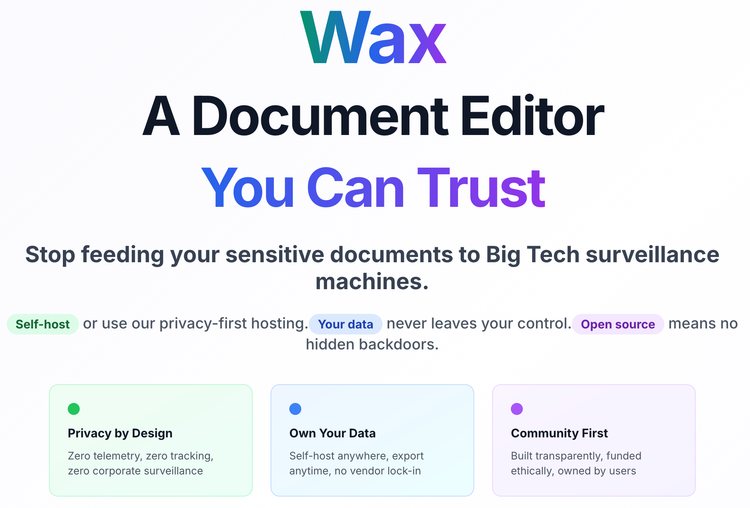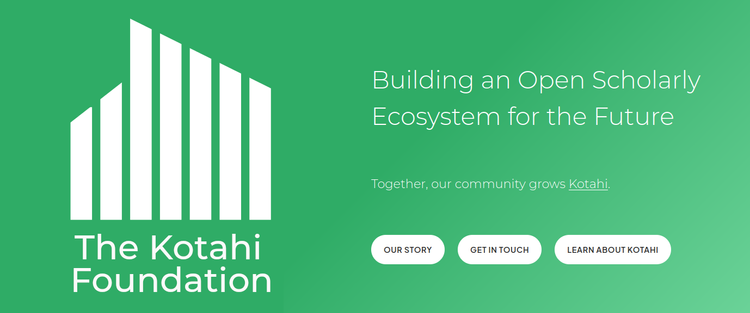Kotahi 2.0: Setting a New Standard in Scholarly Platforms

This early version of a short article about the new Kotahi 2.0 release is coming out on the Coko site shortly. Ketida 2.0 also out this week (!).
For years, the world of academic publishing has relied on traditional submission management systems to handle the submission, peer review, and publication of scholarly work. However, these legacy systems often come with limitations that can hinder efficiency, flexibility, and user experience.
Complex user interfaces designed primarily for internal staff make it difficult for new users to navigate. Rigid, one-size-fits-all submission templates cannot accommodate diverse content types or unique journal requirements. A lack of integrated communication tools leads to email clutter and delays. Production of required formats exists external to most systems with no ability to automate this process. Monolithic architectures restrict workflow versatility and scalability.
The costs of these systems continue to compound over time.
As publishing needs evolve, the demand grows for solutions that are more adaptive, user-friendly, and cost-effective. This is where Kotahi, the new submission management system by Coko, aims to set a new standard.
Built as a modular, open-source platform, Kotahi is designed to be compliant, interoperable, intuitive, and innovative. It solves common pain points faced by publishers and helps streamline workflows for all involved.
Kotahi 2.0 is released today and represents a significant milestone for the platform. Two major new capabilities - multitenancy support and an integrated CMS - transform Kotahi into an end-to-end solution for diverse scholarly publishing needs.
Multitenancy allows a single Kotahi instance to independently host multiple groups, including journals, preprint servers, and review communities. Each group benefits from isolated data, customizable workflows, and unique publishing configurations. This enables simplified management of diverse portfolios at scale.
The modern CMS based on static site generation empowers each group to publish customized branding, pages, and content. An agile yet robust architecture delivers a reliably fast experience.
Together, these features establish Kotahi as a turnkey system for publishing groups of all types. But Kotahi 2.0 goes beyond these highlights to push the boundaries of submission management through an array of innovations:
- Automated JATS and PDF production
- Microservices architecture
- Real-time communications
- Configurable peer review
- AI-powered preprint recommendations
- Open source extensibility
- And much more
This combination of versatility, automation, and customization cements Kotahi's position at the forefront of the next generation of scholarly platforms. Kotahi 2.0 isn't just an upgrade, but a leap into the future of publishing.
Multitenancy Supporting Diverse Use Cases
Managing multiple scholarly publishing groups like journals, preprint servers, or preprint review communities has traditionally required running separate softwares for each one. This quickly becomes cumbersome and difficult to scale as the number of groups grows.
Kotahi resolves this issue by providing native multitenancy support for many use cases within a single integrated system. This allows a single Kotahi installation to host any number of journals, preprint servers, or preprint review communities in the one system.
Each group functions independently with its own:
- Isolated data and privacy
- Customizable submission workflows
- Unique look and feel
- Publish endpoint
The key benefits of Kotahi's multitenant approach include:
- Reduced software overhead since only a single instance needs to be maintained
- Workflows tailored for each group without conflicts
- Easy scalability when adding new groups
- Streamlined cross-group analytics and reporting
- The ability to experiment with new publishing processes within the one system
This architecture substantially reduces the complexity and costs of operating diverse portfolios of journals, preprint servers, and review communities. As publishers scale up their groups, new ones can be easily onboarded while retaining custom workflows.
By supporting this kind of sophisticated multitenancy natively, Kotahi establishes a new standard for flexibly managing any number of publishing groups, with any number of different workflows and use cases, on a single streamlined platform.
A Modern, Powerful, CMS
Kotahi incorporates a modern content management system (CMS) based on static site generation rather than a traditional database-request-driven CMS. This approach provides significant advantages in speed, security, and scalability.
The CMS utilizes a Agile Digital Content Platform (also known as ‘static website generator’) to build simple yet powerful content management focused on scholarly publishing needs. Without a database backend, the resulting website can be blazing fast, infinitely scalable, and far more secure.
Compared to traditional CMSs which can become sluggish and vulnerable at scale, Kotahi's static CMS remains lightning fast and rock solid regardless of traffic or content volume. This innovative architecture ensures publishers can manage content efficiently while providing users with a reliably fast experience. Full text articles are published at a push of a button. The CMS can handle the demands of scholarly publishing both now and in the future.
Automated JATS Production
The Journal Article Tag Suite (JATS) XML standard has become ubiquitous in scholarly publishing, allowing content to be structured, exchanged, and preserved in a consistent machine-readable format. However, many publishers find the JATS format complex and cumbersome to implement manually. The specialized skills and manual effort required drives up costs, hampers efficiency, and creates barriers to adopting this critical publishing standard.
Kotahi aims to change this status quo by integrating JATS production seamlessly into the publishing workflow.
At its core, Kotahi sees a document as a constellation of data, primarily in the form of the manuscript text itself, and associated metadata. Both categories of information are transparent to Kotahi as the system ingests manuscripts at submission time and converts them to an internal file format. Customizable submission forms designed in Kotahi gather comprehensive metadata upfront.
The internal production editor then provides an intuitive way to ready content for JATS export without needing direct XML skills. Users simply visually highlight and tag content sections, with the selections automatically mapped to the appropriate JATS document elements. On demand, Kotahi converts the prepared manuscript and metadata into validation-checked JATS XML that complies with all specifications. This standards-compliant JATS file can also be regenerated as needed throughout the editorial workflow. Kotahi also has an evolving set of tools for the management and validation of citations.
By integrating JATS production into the publishing pipeline in this tailored yet automated manner, Kotahi makes adopting JATS accessible to all publishers. Intuitive tools lower the barrier to entry while facilitating standards compliance at scale. Automating typesetting like this also substantially reduces costs and speeds up publishing turnarounds. With its innovative approach, Kotahi represents the next generation of submission management that seamlessly incorporates critical standards like JATS XML.
Automated Production of PDF
One of Kotahi's standout features is the ability to automatically typeset and generate print-ready PDFs with just a click. This is powered by the integration of Paged.js, an open-source library (also developed by Coko) for paginating HTML content into high-quality PDF documents.
As manuscripts in Kotahi are edited and stored as HTML, Paged.js can fragment the content into pages, inject sophisticated print styling, and paginate a preview right within the browser. When ready, the print-perfect PDF can be saved out - no manual typesetting required.
This browser-based PDF generation approach also enables automated workflows. Kotahi can thus produce press-ready PDFs at scale in a fraction of the time. The result is a system that can take manuscripts from writing to publication-quality typesetting with unparalleled efficiency. Hands-off, consistent, and aesthetically pleasing PDFs become accessible to publishers of all sizes through Kotahi's simple automation.
Drag and Drop Submission Form Creation
Another of Kotahi's standout features is the ability to create submission forms using an intuitive drag and drop interface. This removes the need for any coding knowledge or technical expertise. Users can easily add, edit, remove or rearrange form fields as needed.
Whether working from pre-made templates or designing fully custom forms, the entire process is quick and user-friendly. For authors, filling out submissions becomes simpler, with reduced chances of errors. This results in more complete information being captured upfront, benefiting downstream teams.
Compared to traditional form creation methods which are often complex and time-consuming, Kotahi's drag and drop approach simplifies submission management for publishers and authors alike.
Support for Diverse Metadata Schemas
The submission process for journals and other preprints requires capturing metadata - information about the manuscript itself. However, traditional systems often force one (sometimes more) standardized schemas and lack flexibility.
Kotahi provides versatility by supporting submission through any metadata schemas, including customized or niche standards. This adaptability lets publishers capture optimal metadata for their domain and needs.
Kotahi enables this through its drag-and-drop form builder where any metadata tags can be attached to submission fields. It also supports custom form elements for capturing complex nested data like, for example, detailed author information.
For authors, submitting manuscripts is simpler when providing metadata in appropriate domain-specific schemas. For publishers, post-submission overheads are reduced by capturing comprehensive, flexible, specifc, metadata upfront.
By empowering customized metadata capture, Kotahi ensures journals and publishers get the specific information they need while authors provide it painlessly. This metadata versatility represents a key advantage of Kotahi's submission system.
Tailored Peer Review Process
The peer review process is a crucial element of scholarly publishing. However, traditional systems often enforce a rigid, one-size-fits-all workflow.
In contrast, Kotahi provides flexibility to tailor the review process to each journal, preprint review group, or publisher's specific needs. Different models like open, blind, or double-blind reviews can be configured. Reviewers can collaborate on shared reviews or provide individual feedback.
Kotahi enables customizing the level of author participation as well. Review workflows can allow authors to respond to reviewer comments via threaded discussions as required. The goal is facilitating constructive exchanges to improve the manuscript.
Integration with preprint servers for managing review cycles where the preprint is hosted external to the submission system is also supported.
Whether the preference is for a relaxed open review or a strict double-blind process, Kotahi can accommodate it. Custom reviewer selection criteria, revision policies, feedback tools, and more can be incorporated.
By supporting tailored review workflows rather than fixed processes, Kotahi ensures each group gets the peer review model best suited for its unique needs. This flexibility and customizability result in higher quality, more meaningful reviews.
Real-Time Communication Tools
Effective communication between authors, editors, and reviewers during the submission and peer review process is key. However, email is not always the ideal medium for these interactions.
Kotahi instead incorporates real-time communication features including live chat and video chat to facilitate conversations as needed. All communications become visible within the platform, eliminating email clutter.
Users can quickly get answers, resolve issues, and streamline collaboration all within Kotahi's interface. Smooth end-to-end discussions from submissions to publication become possible.
Microservice Architecture
Kotahi is built using a modular microservice architecture. In contrast to monolithic platforms, components are designed as independent services that work together.
This provides benefits like:
- Scalability: Services can be individually scaled as per demand.
- Flexibility: Services can be modified or replaced without affecting others.
- Resiliency: Issues with one service don't propagate across the system.
As publishing needs grow and evolve, Kotahi's microservices make scaling, upgrading, and maintenance simpler and more cost-effective.
Customizable Task Management
To streamline collaboration among users, Kotahi incorporates advanced but customizable task management capabilities. Project boards provide an overview of tasks and workflows across the publishing lifecycle.
Granular controls allow configuring task management at a per-journal or even per-manuscript level. Critical action items, revision requests, and production tasks can all be managed flexibly. The task manager also includes notification and reminder services as well as the ability to set, start and pause task completion burndowns.
This results in workflows that are tailored to each manuscript's unique needs, while still providing the big picture view across journals.
Versioning
Kotahi supports versioning of submissions to track revision history across review and editing cycles.
Each new submission round creates a new version of both the manuscript content and submission metadata. This allows tracking a and reviewing submissions changes through every step of the process from initial draft to final published form.
As authors revise their manuscripts based on reviewer feedback, a new version is added containing the edits. Reviewers and editors can view previous versions but not edit them.
This version control system is crucial for collaborative workflows where manuscripts go through many stakeholder hands. Kotahi maintains submission integrity and clarity through automated version tracking.
AI-Powered Preprint Recommendations
Kotahi also has some advanced features to support preprint review. For example, Kotahi integrates with Semantic Scholar to enable AI-powered preprint recommendations that assist curators in identifying relevant manuscripts for review.
For preprint servers like bioRxiv new submissions in specified subjects are automatically imported. Curators can then select preprints of interest for review.
Based on these selections, Kotahi leverages Semantic Scholar's API to recommend related preprints that may also warrant review. Checks help ensure only recent submissions from a preconfigured time period, and from approved preprint servers, are suggested.
This tailored AI-matching allows curators to rapidly pinpoint the most pertinent preprints to evaluate and disseminate within their field or community. It enhances the efficiency of preprint screening while surfacing hidden gems curators may have otherwise missed.
Ongoing enhancements continue to expand the flexibility of preprint recommendations in Kotahi. Additional preprint servers, configurable time-filters, and deduplication safeguards help customize the process for diverse needs.
By combining Kotahi's infrastructure with the power of AI semantics, the platform aims to accelerate preprint discovery and review - getting impactful research into the right hands faster.
Configurable, Customizable, and Extensible
Kotahi is designed to be highly configurable, customizable, and extensible to meet diverse publishing needs.
The system already allows individual configuration of workflows, review models, metadata schemas, task management, and more per group. This enables tailored setups without software the need for developer assistance.
Further customisation can be achieved through integrations, plugins, addition of new microservices or new functionality and the Kotahi team is ready to support organizations wanting to customize, extend, or configure the system to their needs. Whether it's tailored workflows or custom enhancements, Kotahi provides the versatility to meet publishing requirements and Coko is here to support you.
100% Open Source
Kotahi is published under open source licenses, with all source code freely available. This enables publishers full freedom to use, modify, and distribute the software to meet their needs.
As open source software, Kotahi benefits from community contributions and transparency. Anyone can inspect the codebase, propose improvements, report issues, or create customizations.
This open development model also helps drive rapid innovation as the platform evolves via public peer review. Organizations can collaborate to extend Kotahi rather than reinventing the wheel.
By being 100% open source, Kotahi represents a publishing platform unencumbered by proprietary restrictions. This liberates publishers to fully utilize Kotahi as a strategic asset customized for their requirements.
Conclusion
In summary, Kotahi offers a refreshing modern take on scholarly submission management. The platform aims to solve multiple pain points faced by publishers and researchers when using legacy solutions.
Features like intuitive drag and drop interfaces, flexible metadata support, typeset automation, multiple use-case multitenancy support, real-time communication, and modular architecture set Kotahi apart. The system streamlines and connects workflows end-to-end across the research lifecycle.
As publishing demands continue to evolve, Kotahi represents the next-generation of scholarly platform. Its innovative approach promises to enhance everything from author experience to improved forms of publishing, setting a new standard for the industry.
© Adam Hyde, 2024, CC-BY-SA
Image public domain, created by MidJourney from prompts by Adam.



Member discussion